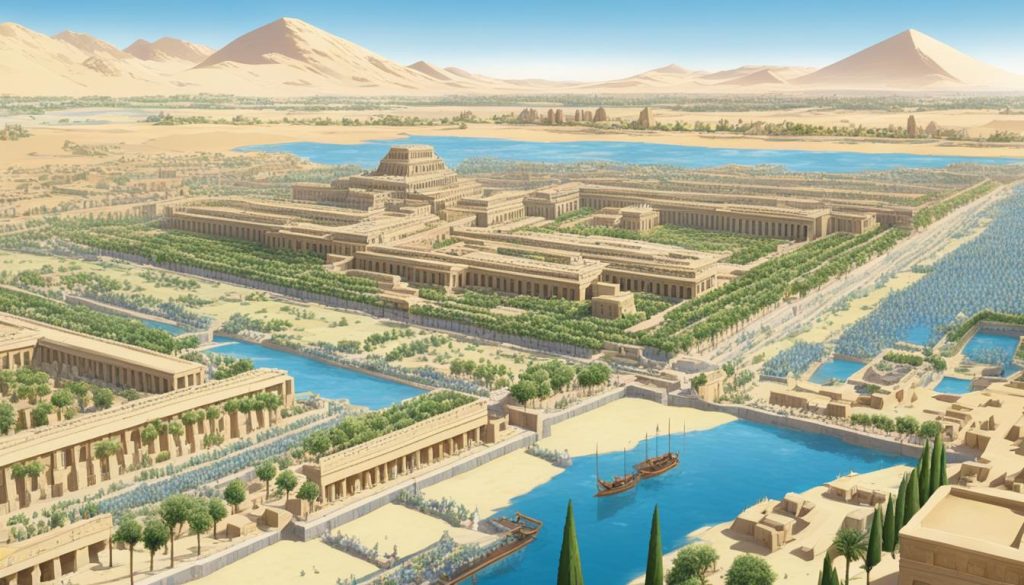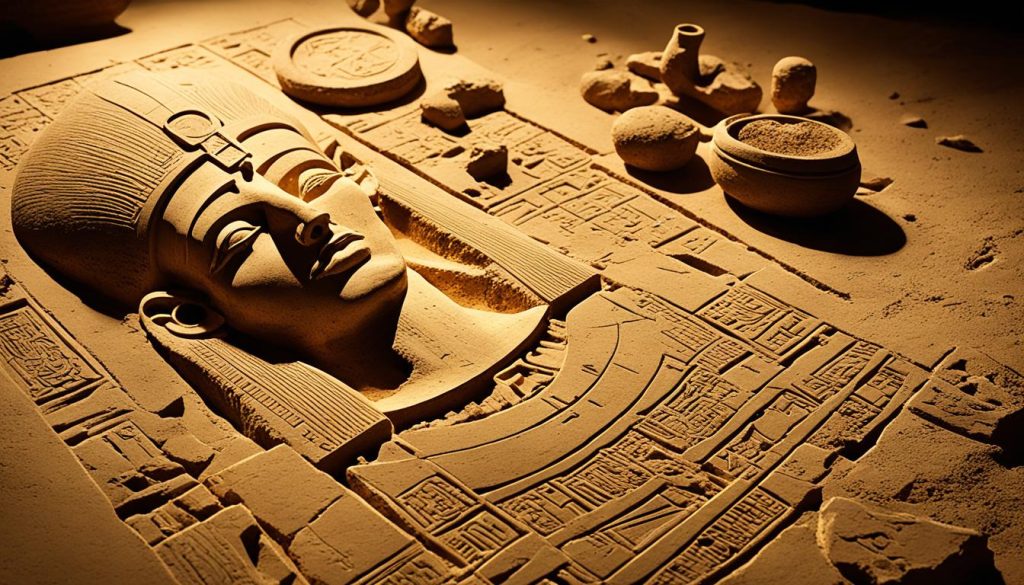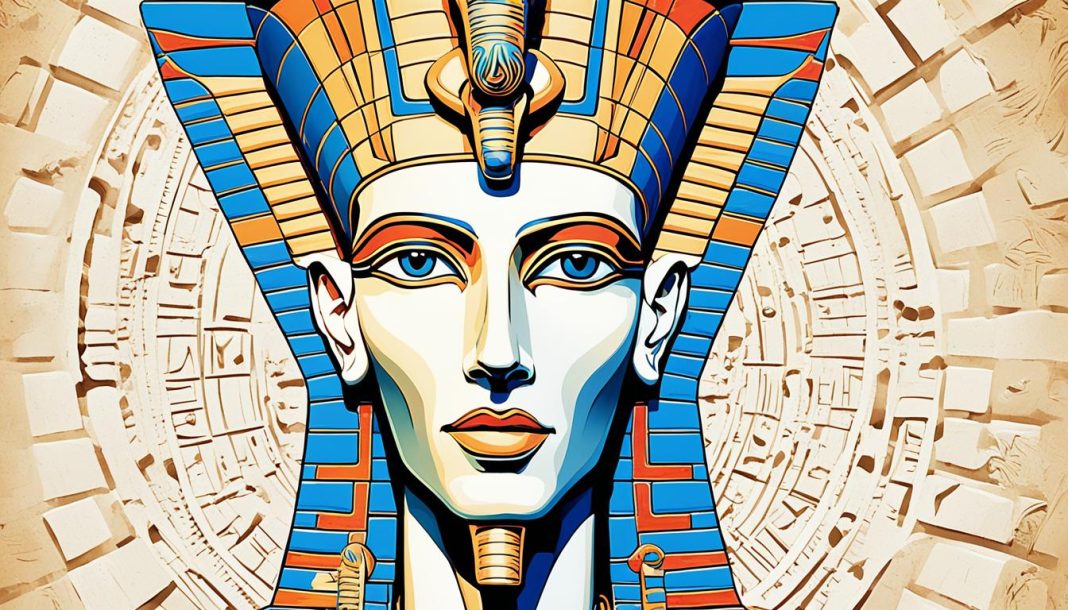Pharaoh Akhenaten, the ancient Egyptian king who sparked a religious revolution during the Amarna period, has long captivated the imaginations of scholars and historians. His monotheistic beliefs, rejection of traditional polytheism, and enigmatic life have left a legacy that still intrigues us today. Who was this Egyptian king, and what impact did he have on ancient history?
Key Takeaways:
- Akhenaten was an ancient Egyptian king during the Amarna period.
- He introduced monotheism and rejected the traditional polytheistic beliefs of ancient Egypt.
- His reign sparked a religious revolution and had a lasting impact on ancient history.
- Akhenaten’s mysterious life and unique physical appearance continue to fascinate researchers.
- Exploring the enigma of Pharaoh Akhenaten provides insights into the religious and cultural shifts of ancient Egypt.
The Golden Years
Akhenaten, originally named Amenhotep IV, was born into the prosperous and powerful reign of his father, Pharaoh Amenhotep III. Amenhotep III’s rule, known as the Golden Age, marked a period of immense prosperity and artistic and international power for ancient Egypt. Akhenaten grew up in this opulent era, surrounded by luxury and wealth.
Amenhotep III, often referred to as the Magnificent, ruled over ancient Egypt during a time of unparalleled splendor. His reign saw the flourishing of art, architecture, and international diplomacy. Under his leadership, Egypt became an artistic and cultural powerhouse, attracting admiration and reverence from neighboring kingdoms. Amenhotep III’s influence extended beyond Egypt’s borders, establishing the nation as a significant player on the world stage.
“The rule of Amenhotep III represented the pinnacle of ancient Egyptian civilization, a Golden Age that left an indelible mark on history.” – Egyptologist Dr. Sarah Johnson
Akhenaten, being a direct successor to such a prosperous and influential pharaoh, inherited a stable and prestigious kingdom. He witnessed the grandeur of ancient Egypt at its zenith, giving him a unique perspective on the country’s artistic and international power.
During this period, the arts flourished, with monumental temples, statues, and intricate carvings adorning the ancient Egyptian landscape. The wealth generated from trade and conquest allowed for the construction of breathtaking structures and the patronage of talented artisans. This artistic renaissance showcased Egypt’s immense wealth and cultural prowess to the world.
Akhenaten’s exposure to the artistic achievements of his father’s reign undoubtedly shaped his own artistic endeavors later in his rule. The wondrous accomplishments of the Golden Age set the stage for Akhenaten’s unique artistic style and his bold religious reforms.
Becoming a Pharaoh
Akhenaten’s journey to the throne began with an unexpected turn of events. Following the untimely death of his older brother, Thutmose, Akhenaten emerged as the new Crown Prince and heir to the Egyptian throne. This pivotal moment in his life set the stage for his future as a pharaoh, shaping the course of ancient Egyptian history.
As a member of the royal family, Akhenaten likely underwent extensive training and preparation for his role as pharaoh. The Temple of Ptah in Memphis played a crucial role in the education of royal heirs, and it is possible that Akhenaten received instruction there as well. This temple served as a center for religious and political activities, offering a comprehensive education to those destined for leadership.
Furthermore, there is evidence to suggest that Akhenaten participated in a coregency with his father, Pharaoh Amenhotep III, before his father’s death. This shared rule allowed Akhenaten to gain valuable experience and insight into the intricacies of governance, preparing him for the challenges he would face as the sole ruler of Egypt.
Akhenaten’s path to power was marked by tragedy and preparation, ultimately leading him to ascend the Egyptian throne. Through the guidance he received at the Temple of Ptah and his co-rule with his father, Akhenaten was equipped with the knowledge and skills necessary to steer the course of the ancient Egyptian civilization during his reign.
The Rise of the Heretic
After assuming the throne, Akhenaten underwent a religious awakening and embraced the worship of a previously lesser-known sun god, Aten. He introduced Atenism, a monotheistic religion that denounced the polytheistic beliefs of ancient Egypt. This radical shift challenged the powerful priesthood of Amun, headed by the god Amun-Ra. Akhenaten sought to centralize religious authority and erase the influence of other gods and goddesses, leading to a tumultuous period of religious reforms in ancient Egypt.
The Shift from Polytheism to Monotheism
Akhenaten’s embrace of Aten, the sun disk, marked a departure from the longstanding polytheistic traditions of ancient Egypt. He believed in the singular power of Aten as the source of all life and divinity. By promoting Aten as the supreme deity, Akhenaten aimed to consolidate religious worship and establish a new order in ancient Egyptian society.
Atenism posed a direct challenge to the priesthood of Amun, which held significant power and influence over religious affairs. The priests of Amun were the intermediaries between the gods and the pharaoh, and they enjoyed immense wealth and authority. Akhenaten’s rejection of the old gods threatened the privileged position of the Amun priesthood and triggered a clash between the traditional religious establishment and the pharaoh.
The Struggle for Religious Authority
Akhenaten’s religious reforms sparked controversy and resistance from those who upheld the polytheistic traditions of ancient Egypt. The Amun priesthood, in particular, vehemently opposed the shift towards Atenism. They saw their centuries-old religious practices undermined and their power threatened by Akhenaten’s monotheistic vision.
As a result, Akhenaten engaged in a power struggle with the Amun priesthood, seeking to weaken their influence and assert his own authority as the sole mediator between Aten and the Egyptian people. This clash of religious ideologies further divided the Egyptian society, contributing to the instability and turmoil of the period.
The Legacy of Akhenaten’s Reforms
Akhenaten’s religious reforms, though met with resistance, left a lasting impact on ancient Egyptian society. Atenism laid the foundation for future monotheistic beliefs and influenced subsequent religious developments in the region. The vacuum created by Akhenaten’s rejection of traditional deities and his focus on Aten led to a reevaluation of religious practices and belief systems.
Moreover, Akhenaten’s ambitious attempts to centralize religious authority and erase the influence of other gods and goddesses set a precedent for the pharaohs who followed him. The concept of pharaonic divinity and the pharaoh’s role as the sole intermediary between the gods and the people became more pronounced, shaping the religious landscape of ancient Egypt for centuries to come.
In the next section, we will explore the impact of Akhenaten’s religious reforms on the new capital of Amarna and the wider political stability of ancient Egypt.
The Impact of Akhenaten’s Reforms
As part of his reforms, Akhenaten made a significant move by establishing a new capital city called Amarna. This decision had profound symbolic implications as it aimed to establish a centralized authority away from the traditional centers of power in Memphis and Thebes. The creation of Amarna was a bold statement of Akhenaten’s religious and political changes.
However, the implementation of these reforms was not without consequences. The radical shift in religious practices and abandonment of the traditional polytheistic beliefs in favor of Atenism created instability within the kingdom. The priesthood of Amun, which held significant power and influence, was threatened by Akhenaten’s monotheistic beliefs, leading to rebellions throughout the kingdom. The rebellion against the religious reforms was so significant that after Akhenaten’s death, his successors actively sought to erase his legacy by reinstating the traditional polytheistic worship.
In addition to the domestic challenges, Akhenaten’s neglect of foreign affairs weakened Egypt’s influence in the region. Despite neighboring kingdoms facing threats, Akhenaten refused to provide military support, further isolating Egypt from its allies and potential diplomatic alliances. This resulted in a decline in Egypt’s prominence and influence in foreign affairs, damaging the overall stability and strategic position of the kingdom.

The repercussions of Akhenaten’s reforms had long-lasting effects on Egypt’s political and religious landscape. The move to Amarna and the subsequent instability and rebellion highlight the challenges of implementing drastic religious and political changes. While Akhenaten’s reign left an indelible mark on ancient Egypt, his reforms ultimately led to a decline in stability and weakened foreign relations.
The Mystery of Akhenaten’s Appearance
Akhenaten, the enigmatic pharaoh of ancient Egypt, has long perplexed historians and archaeologists with his distinctive physical attributes. Depictions of Akhenaten reveal elongated limbs, a distended abdomen, and an elongated neck, leading to much speculation about his origins and identity.
Some theories suggest that Akhenaten’s unusual appearance may be evidence of extraterrestrial origins or divine lineage. However, modern medical research offers a different explanation for his physical characteristics: Marfan syndrome.
Marfan syndrome is a genetic disorder that affects the body’s connective tissues, often resulting in elongated limbs, a tall stature, and other physical anomalies. This condition can also cause a distended abdomen and an elongated neck, which aligns with the depictions of Akhenaten.
The discovery of a possible medical explanation for Akhenaten’s appearance dispels some of the mystique surrounding him, grounding his extraordinary features in a scientific context. It highlights the importance of considering physical attributes in the historical analysis of individuals and dispelling unfounded speculations.
The Coins of Akhenaten
Coins believed to be associated with Akhenaten have been discovered, featuring figures with bulbous heads and almond-shaped eyes.
These ancient coins have sparked debate among scholars regarding their authenticity and their potential connection to Akhenaten’s reign. While some believe they provide evidence of an otherworldly connection, others argue that they may be elaborate fabrications or unrelated to Akhenaten altogether.
The mystery surrounding these coins adds another layer of intrigue to the enigma of Akhenaten.
The Mosaic of Medusa
In ancient Italy, the Villa of the Antonines holds a hidden treasure that continues to bewilder researchers – a captivating mosaic depicting the enigmatic figure of Medusa. This ancient artwork, adorned with intricate details and vibrant colors, has been a source of fascination and intrigue for historians and art enthusiasts alike.
The purpose behind the creation of this mosaic and its significance within the grandeur of the Villa of the Antonines remains a subject of speculation and debate. The mere presence of Medusa, a mythological creature known for her petrifying gaze, adds an air of mystery and invites us to uncover the hidden meanings and symbolism embedded within ancient Roman art.
A Glimpse into the Past
This remarkable mosaic provides us with a captivating glimpse into the artistic prowess of ancient Italy. Its craftsmanship and attention to detail showcase the skill and dedication of the artisans who crafted such intricate artworks. As we explore the Villa of the Antonines and immerse ourselves in the beauty of its mosaic, we are reminded of the rich cultural heritage that has shaped our understanding of ancient civilizations.
Unraveling the Enigma
The mysteries and enigmas surrounding Pharaoh Akhenaten continue to captivate scholars and enthusiasts alike. From hidden truths to perplexing artifacts and historical discoveries, each revelation adds another piece to the puzzle of this ancient Egyptian ruler. While some aspects of Akhenaten’s life can be explained through historical and scientific analysis, others remain shrouded in speculation and myth.
Unraveling the true nature of Pharaoh Akhenaten and his reign requires a careful examination of the available evidence and a deep exploration of the myths and legends that surround him. The discovery of additional clues and a thorough evaluation of ancient texts and archaeological findings may bring us closer to understanding the complexities of this enigmatic pharaoh.
“The hidden truths and mysterious artifacts associated with Akhenaten offer glimpses into a world that was both extraordinary and enigmatic.”
Speculation plays a significant role in unraveling the enigma of Akhenaten, as scholars and experts engage in thoughtful analysis and debate. Theories range from his religious beliefs to his physical appearance, providing different perspectives and interpretations of this ancient figure.
The Role of Speculation
In the quest for answers about Akhenaten, speculation serves as a catalyst for exploration and discovery. It encourages researchers to delve deeper into historical records, unearth hidden artifacts, and challenge prevailing theories. Speculation ignites curiosity, leading to new insights that may bring us closer to unraveling the hidden truths surrounding Pharaoh Akhenaten.
Legends and myths have enveloped Akhenaten, further adding a layer of intrigue. Tales of his radical religious reforms and the fabled city of Amarna have fueled imaginations for centuries. Separating fact from fiction requires careful analysis and a critical evaluation of the available evidence.

The discovery of perplexing artifacts offers tantalizing clues about Akhenaten and his reign. These artifacts, ranging from sculptures to inscriptions, shed light on his religious practices, artistic preferences, and royal lineage. Each artifact possesses its own story, waiting to be decoded and understood.
Continued research and exploration of the historical context surrounding Akhenaten will help unravel the hidden truths and mysteries that surround him. By analyzing the available evidence, engaging in respectful debate, and embracing a multidisciplinary approach, we inch closer to understanding the complex world of ancient Egypt and the enigma of Pharaoh Akhenaten.
Conclusion
Pharaoh Akhenaten, the enigmatic ruler of ancient Egypt, continues to fascinate historians and researchers with his groundbreaking religious revolution and mysterious appearance. His reign marked a significant shift in religious practices, as he introduced a monotheistic belief system and challenged the powerful priesthood of Amun. The enduring mysteries surrounding Akhenaten, such as his elongated limbs and bulbous-headed depictions, have sparked speculation about his origins and connections to otherworldly beings.
While historical and scientific analysis has shed some light on Akhenaten’s life, many questions still remain unanswered. The exploration of his legacy serves as a reminder that there are still hidden truths and perplexing artifacts waiting to be discovered in the depths of ancient Egypt. As we unravel the enigma of Akhenaten, we gain a deeper understanding of the historical mysteries that continue to captivate our imaginations.
Pharaoh Akhenaten’s reign and legacy represent a pivotal moment in ancient history, where religious, cultural, and political upheaval collided. His unique contributions continue to inspire research and fuel speculation, reminding us of the rich tapestry of historical exploration. As the study of ancient Egypt progresses, we can only hope to uncover more clues and gain further insights into the enigmatic life of Pharaoh Akhenaten.
























